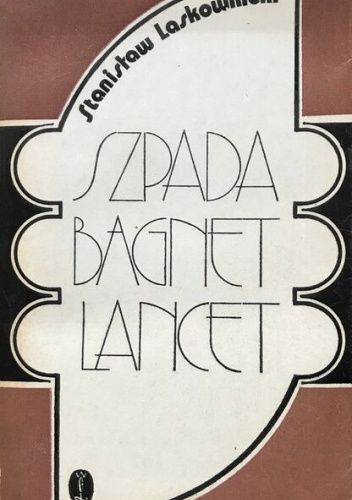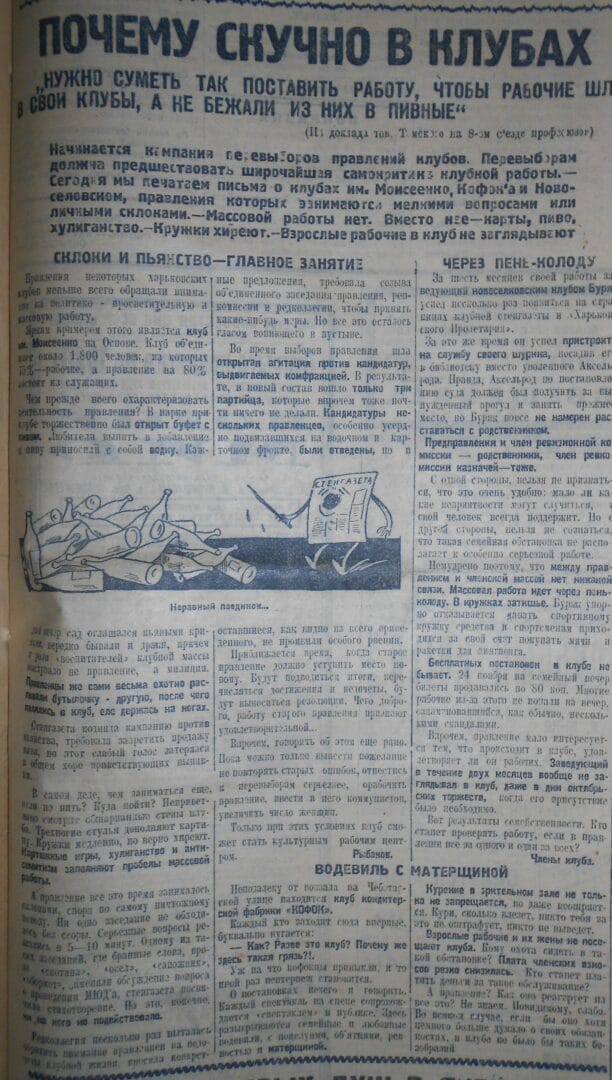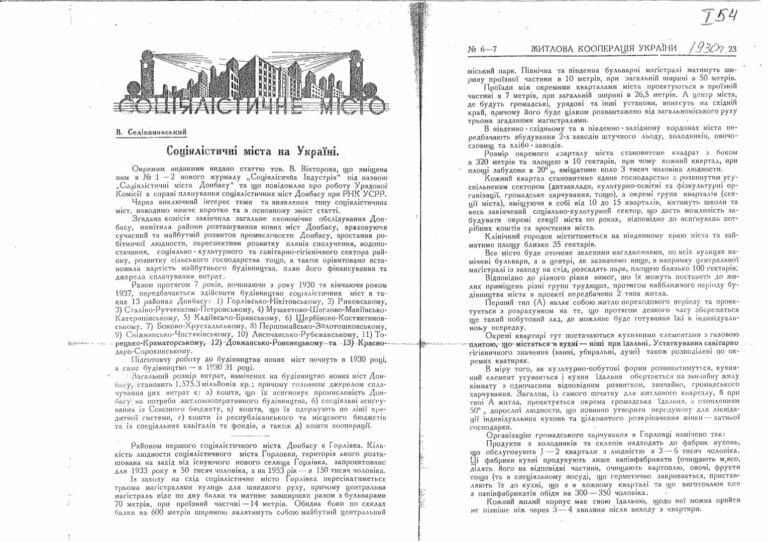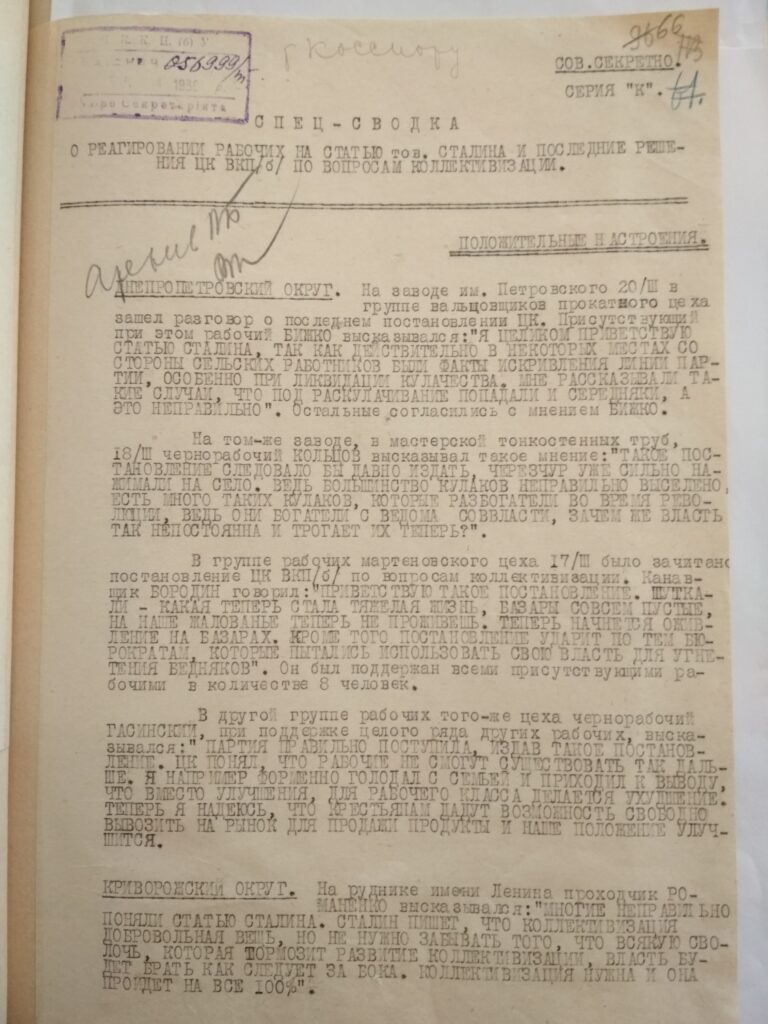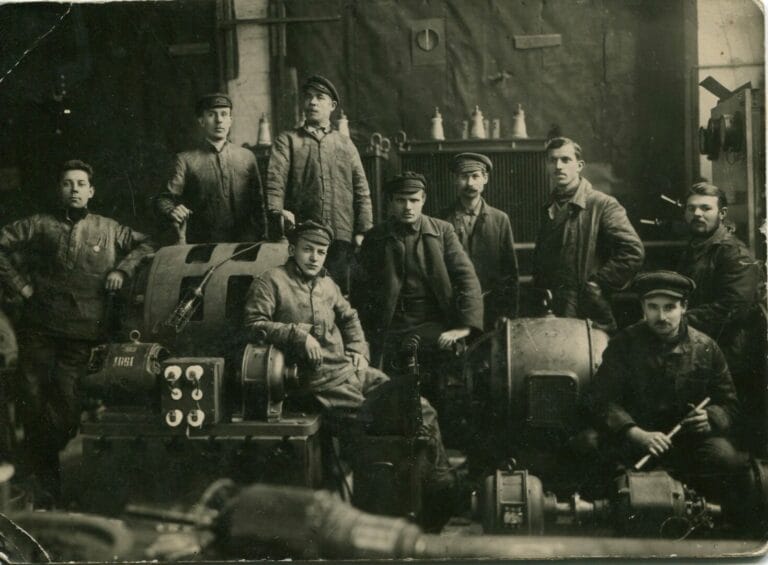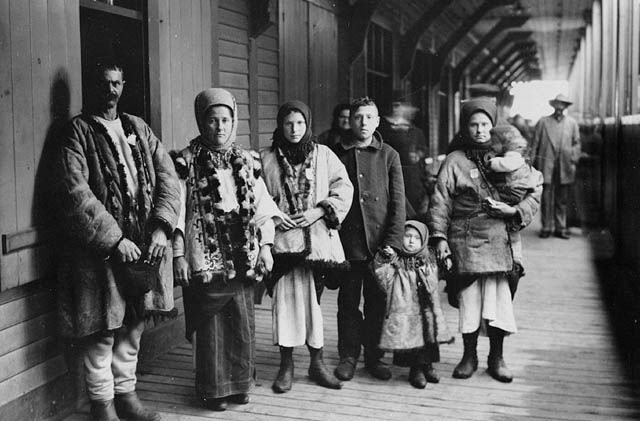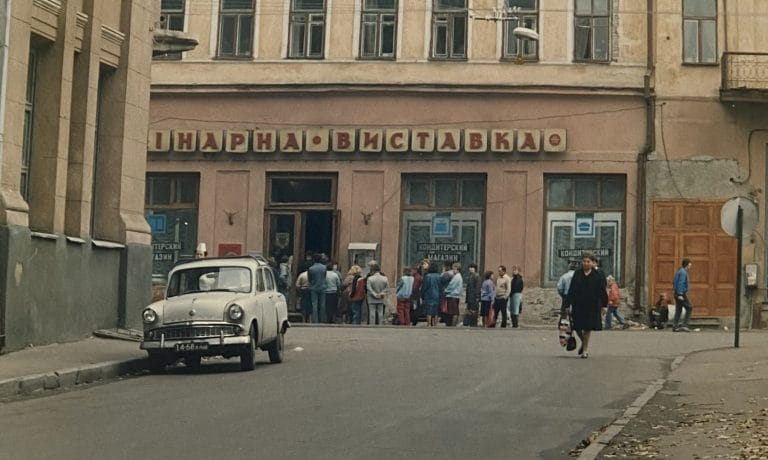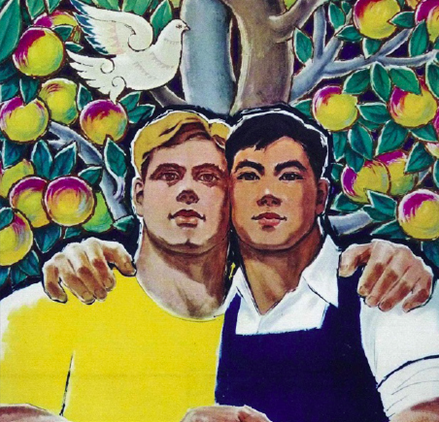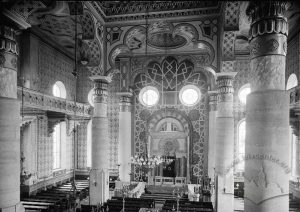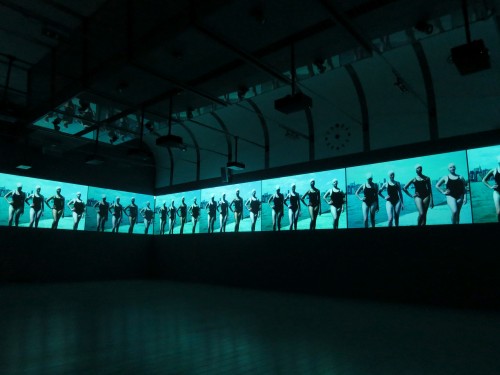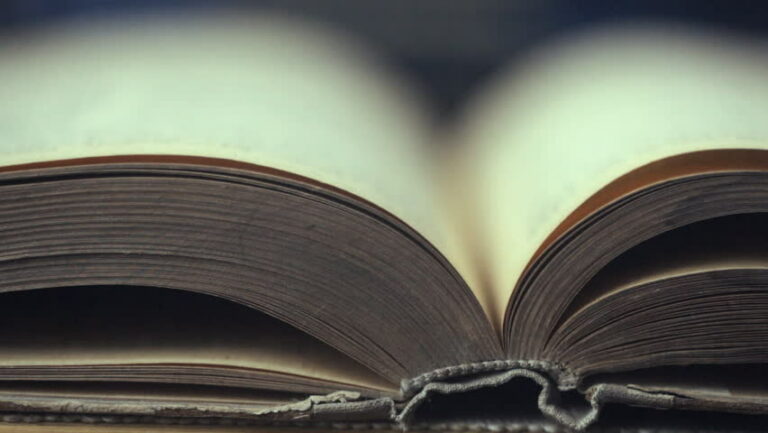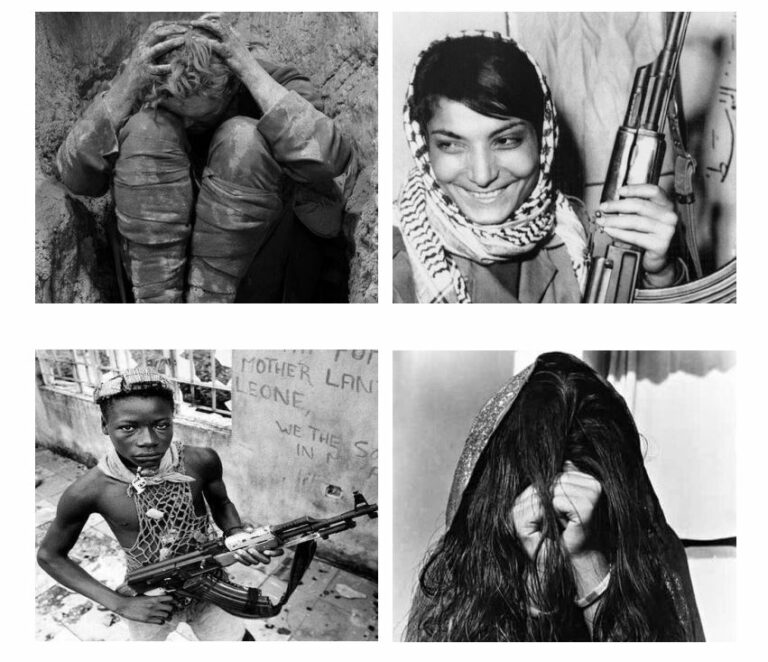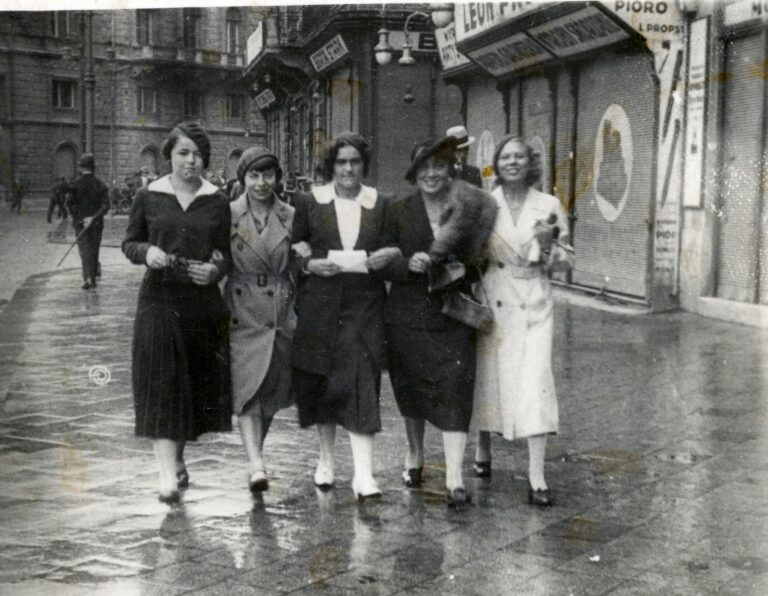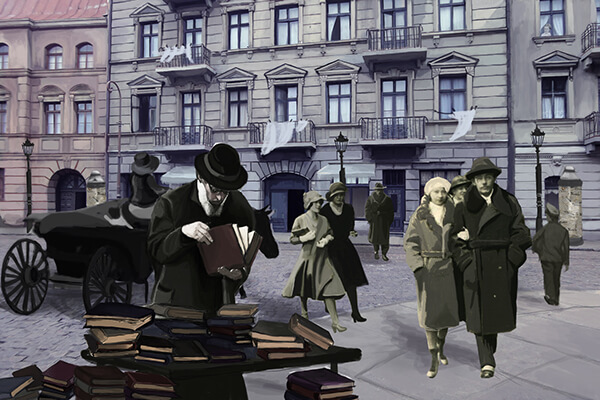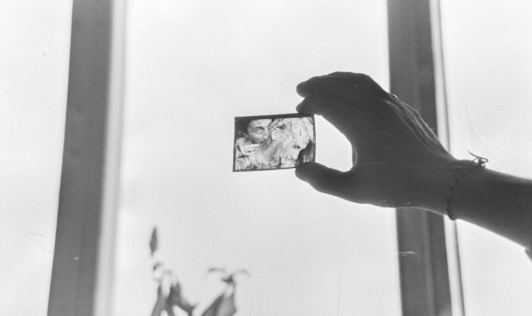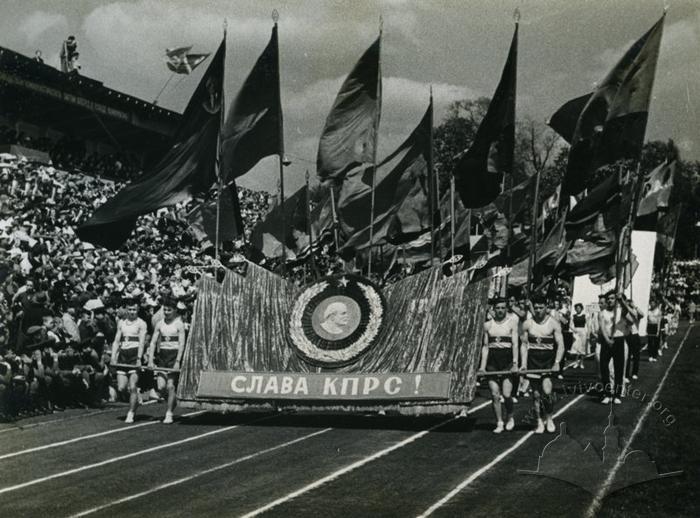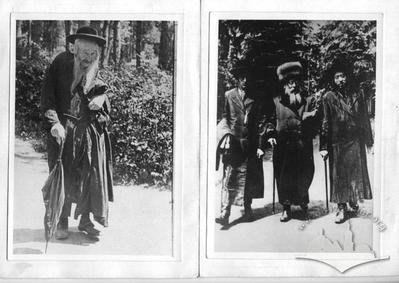1930s
Primary Sources

Excerpt from Chone Gottesfeld’s travelogue ‘My Trip to Galicia’, dedicated to Galician town of Skala (1937)
Returning three decades after his emigration, journalist Chone Gottesfeld of the New York Yiddish newspaper Forverts (פֿאָרווערטס) found his hometown of Skala—today known as Skala-Podilska—in a state of prolonged decline. According to the 1900 census, the town had 5,638 inhabitants, of whom Jews made up nearly half (2,494). By the time of the last census in 1931, Skala’s population had fallen to 4,017, with just 1,460 Jews remaining. More broadly, towns across Galicia never recovered from the devastation of the First World War. During the interwar period, their main source of income—trade with the Russian Empire—had become impossible. As Gottesfeld’s account makes clear, the local population now had virtually no means of subsistence....

Excerpt from Chone Gottesfeld’s travelogue My Trip to Galicia (1937): “The shtetl is dying out. And this is not the only shtetl in Galicia.”
This excerpt continues journalist Chone Gottesfeld’s reflections on his hometown of Skala, which he left thirty years earlier when he emigrated to America. After visiting Galicia in 1936, he wrote a travelogue whose impressions were first published in the newspaper Forverts (Forward, official Yiddish title: פֿאָרווערטס) and later released as a separate book. It is clear that one of his implicit aims was to encourage financial support for Galician Jews, which is why he focuses primarily on describing their hardships in detail. In this passage, the author highlights the main factors behind the town’s decline, particularly demographic changes driven by economic hardship and recurring epidemics. The head of the Jewish community explains...

Excerpt from Chone Gottesfeld’s travelogue ‘My Trip to Galicia’, dedicated to Ternopil (1937)
This excerpt is taken from a travelogue of impressions and experiences by the renowned journalist Chone Gottesfeld of the New York Yiddish-language newspaper Forverts (Yiddish: פֿאָרווערטס, English: The Forward), published in New York in 1937. In it, the author recounts a journey to his hometown of Skala, which he had left in 1907. At the time, Skala was an atypical Galician town that had flourished during the Austrian period due to the large number of Hasidic pilgrims visiting local tzaddikim in nearby Chortkiv. However, the town fell into decline during the interwar years. Gottesfeld, known for his humorous newspaper stories and for plays performed in both New York and Warsaw, offers in this...

An excerpt from Chone Gottesfeld’s travelogue ‘My Trip to Galicia’, dedicated to Lviv (1937)
Chone Gottesfeld, a well-known journalist for the Yiddish-language newspaper Forverts (Yiddish: פֿאָרווערטס [Forward]) in New York, visited Galicia and documented his impressions in a detailed travelogue, My Trip to Galicia, published by the Association of Galician Jews in America in 1937. His journey was a return to his native land, which he had left three decades earlier, in 1907. The travelogue offers a rich tapestry of comparisons between social life during the Austrian and Polish periods, based both on Gottesfeld’s personal memories and the testimonies of those he encountered. This excerpt also sheds light on the formation of collective memory among Galician Jews during the interwar period. It explores how they recalled the...

“Negotiations in Brest-Litovsk” by Leon Trotsky, 1930
Leon Trotsky’s My Life: An Attempt at an Autobiography (1930) is a memoir by one of the Russian Revolution’s key figures. Covering his childhood, the Revolution, and the Soviet Union’s first decade, it concludes with Stalin’s rise and Trotsky’s exile. “Telling my story, I defend myself and even more frequently attack,” he writes. The memoir reflects the influence of its context, with Trotsky’s self-criticism often replaced by myth-breaking and detailed explanations to clear his name. This is exemplified in the Brest-Litovsk chapter, where Trotsky’s actions as First Commissar of Foreign Affairs were first deemed risky, later treasonous, and eventually conspiratorial. His testimony offers a critical source for reconstructing events and examining how memory...

Report of the Intelligence Unit ІІ of the Border Guard Service of Poland on the Food Supplies Situation in the Soviet Kharkiv
The document presents a report of the intelligence division of the Second Unit of the Border Guard Service of Poland in Kharkiv about the situation with food supplies in the city and the mass departure of foreign (German) specialists from Ukraine and the Soviet Union. The document is dated of March 5, 1933, the most critical time of the Holodomor famine in 1932-1933. The document’s author does not use the word “famine,” but the report includes multiple direct testimonies of starvation and food crisis. The author describes them and also adds his sarcastic and critical comments about the nature of Soviet rule and the impact of its political and economic course on the...
Show more
Collapse all
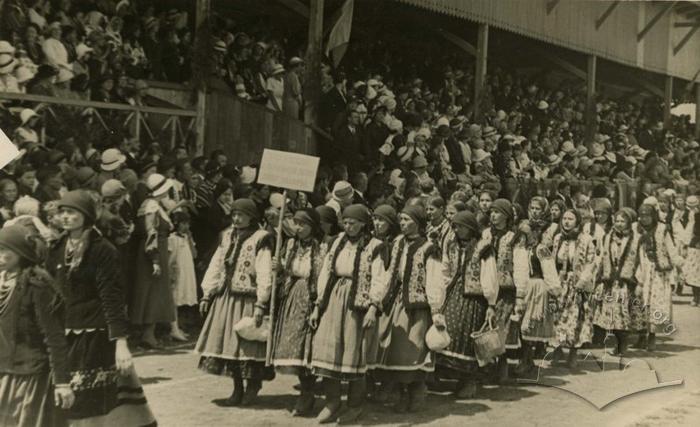
Celebration at the Stadium of the Ukrainian Sokil-Batko, Lviv, 1934
The event captured in the image takes place at the stadium of the Ukrainian Sokil-Batko, likely during the third and final Regional Sokil gathering in 1934. The first Ukrainian gymnastic society, Sokil (Sokil-Batko [Father Falcon]) was founded in Lviv on February 11, 1894. The model was the charter of the Czech Sokol (1862, founded by Miroslav Tyrš). The goal of the society was fostering national unity, strength, and dignity among Ukrainians while also promoting endurance, agility, entrepreneurship, and discipline. Beyond gymnastics, Sokil placed significant emphasis on firefighting and tourism. The society’s first chairman, serving until 1900, was the renowned architectural engineer Vasyl Nahirnyi. By 1900, Sokil had expanded its activities across Galicia, leading...

“Oh, in the meadow blooms the red viburnum,” a Ukrainian resistance song
This source is an audio recording of the folk version of the one of the most popular Ukrainian resistance songs. It is known by various titles: “The rifleman’s Anthem,” [Cтрілецький гімн] “The song of the viburnum,” [Пісня про калину] or “Oh, in the meadow blooms the red viburnum” [Ой у лузі червона калина]. The song’s worldwide spread was facilitated by the performance of Andriy Khlyvnyuk, the lead singer of the Boombox band, who on February 28, 2022, the fourth day of Russia’s full-scale attack on Ukraine, sang only the first stanza of the song. His performance on St. Sophia Square in Kyiv led to the emergence of remixes. Among the many performers are...
The Soviet government aimed to profoundly transform the styles and structures of people’s everyday lives, encompassing housing, leisure, and work. Particularly ambitious projects were conceived and executed during the 1920s and 1930s. Workers were at the forefront of Soviet social policy, with the Bolshevik Communist Party depicted in Soviet discourse as the avant-garde of the proletariat, primarily serving the interests of the working class. Did these ideas correspond to practice, and at what cost were they realized? This will be discussed in the module by historian Roman Liubavskyi.
The end of the 19th century through the beginning of the 20th century is known as the period of mass migration from Europe to other continents, when more than 55 million people changed their place of residence. In particular, this process captured the Russian and Austro-Hungarian empires, where a difficult economic situation, job shortages, and persecutions stirred various groups of the population to leave. Such groups included both Ukrainian and Polish peasants, and Jews from urban centers who were small-scale craftsmen or workers. Most often, they moved to the United States, Canada, Argentina, and Brazil, where labor was needed at factories or farms.
Reflections

Portrait of Kyivan Prince Yaroslav the Wise by Soviet Historiography
In the 1930s, the Kyivan Prince Yaroslav the Wise sarcophagus was repeatedly the subject of scientific research attended by historians, doctors, museologists, anthropologists, and other scientists. For example, on 25 January 1936, a commission headed by the director of the Museum Town, M. Bahrii, examined the contents of the sarcophagus for the first time. At the bottom of the sarcophagus, they found a disorderly accumulation of bones belonging to a man and a woman, as well as small fragments of a child’s skull. The sarcophagus was opened for the second time in 1939. At that time, the commission, which included the famous Soviet scientist V. Ginzburg, decided to transfer the recovered bone remains...
In the last decade, the Ukrainian parliament has issued two laws outlining the legal framework for dealing with the Russian imperial and Soviet past. These laws have sparked numerous scholarly debates on how to address the imperial past, Ukraine's status as part of the Romanov Empire and the Soviet Union, and what to do with the cultural products created over the centuries. This course aims to explore the Soviet legacy in present-day Ukraine and provide students with the necessary theoretical and methodological tools for studying, researching, and writing about Soviet history and culture. The implications for modern Ukrainian identity and politics, particularly in the context of the ongoing war with Russia, will be...
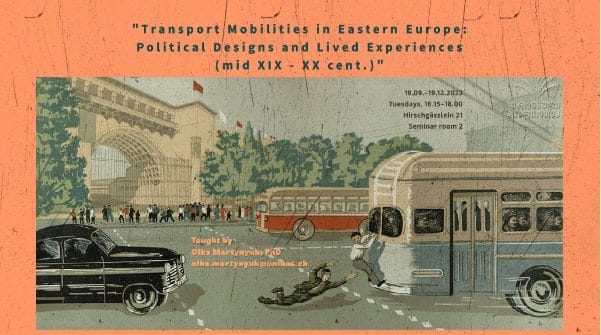 Transport Mobility in Eastern Europe: Political Designs and Lived Experiences (mid XIX – XX Century)
Transport Mobility in Eastern Europe: Political Designs and Lived Experiences (mid XIX – XX Century)
The course invites to explore East-European History of mid XIX - late XX cent. through the concept of mobility, which encompasses movement of people, goods and ideas. Students will deal with a corpus of texts on social history of transportation, as well as with a rich array of visual materials. Of special interest will be cases, specific to the region, for example cultures of Christian and Muslim pilgrimage, Socialist rallies, trolleybus infrastructures or “destalinization” of metro stations. Cases of imported western technologies will provide ground for interregional comparisons, not only in aspects of introduction of transport system, but also in aspects of their exploitation and disintegration. The course is built on a premise...
The course invites to look at the history of Soviet Ukraine from the perspective of its everyday practices. Using many visual sources from 1922 to 1991, students will explore daily routines, housing, clothing, transportation, leisure, and music consumption in urban and rural settings. Periods of peace, war, and crisis will receive equal attention so that one can see how global developments were experienced on a microlevel. Students will explore how maintaining everyday objects and personal habits was essential for building personal safety in different historical contexts. The everyday histories of Soviet Ukraine will also provide a deeper insight into the standard historical narratives about East-European societies, particularly their dialogue with the global society...
East-Central Europe played a vital role in the global history of mass migration and experienced an enormous variety of mobility processes in the long 19th and short 20th centuries. For instance, mass emigration from the Russian and Austro-Hungarian Empires and the Soviet Union, human trafficking, labor migration, forced migration during WWI and WWII, refugee crises and asylum, travel, and professional mobility. The voluminous scholarship on this chapter of migration history has lots of gaps and, notably, is almost absent from history curricula. This introductory course broadens our lens to examine the role of migration and mobility for the places where it occurred as well as the experiences of migrants, displaced persons, refugees, and...
This lecture course comparatively and transnationally investigates twentieth-century communism as a modern civilization with a global outreach. It looks at the global spread of communism as an ideology, an everyday experience, and a form of statehood in the Soviet Union, Europe, Asia (i.e.Mao’s China), and post-colonial Africa. With the exception of North America and Australia, communist regimes were established on all continents of the world. The course will examine this historical process from the October Revolution (1917) to the Chernobyl nuclear disaster (1986), which marked the demise of the communist state. The emphasis is not just on state-building processes or Cold War politics but primarily on the social, gender, cultural and economic policies that...
The course explores the history of Russia as an empire from Peter I up to now in the methodological perspective of the new imperial history. What are the historical preconditions and sources of Russian imperialism and militarism? How did the small principality of North-Eastern Europe manage to create the largest empire in the world? To what extent the Russian Empire of the 18th and 19th centuries differed from European colonial empires as well as eastern imperial polities such as Ottoman Empire and China? How did the imperial nationalities policies emerge and evolve? What role did the competition between "great powers" play in turning Russia into an empire? The course attempts to answer these...
The field of social history has achieved the edge of its popularity in 1950-1980s. It was strongly connected with other disciplines, such as economics, demography, sociology, and allowed historians to reach a much wider range of research themes. Since the 1960s, the social history of the Jewish people became important and influential part of the studies. Historians were exploring the possibilities to study Jewish community with new tools and integrating different representatives of Jewish community – workers, women, immigrants, criminals - in a research. Since 1990s historians of Jewish past shifted their interest to cultural studies. However, in the last years, we can see an economic turn, which signifies the search for a...
The aim of the course is to get to know how to analyze examples of visual culture, including: fiction films and documentaries, video, photography. Both contemporary and historical materials will be studied, together with theoretical texts and publications (from the area of film and media studies, anthropology, cultural studies and history. Although images are mostly seen, if you want to really know them and understand them really well, you must not only "see" them but also "read" them, that means to analyze them as a complex message/ text. That is why at our course we will firstly discuss some terms and categories, that would help us to read images such as: composition, convention,...
This course forms a part of Jewish History and Culture of East Central Europe in the 19th-20th Centuries summer school. The syllabus is availible only in Polish.
The course aims to discuss the major military conflicts of the twentieth century from a gender perspective. In doing so, the course covers the history of global and local wars in a wide variety of regions, including Europe, Africa, and Asia. However, rather than surveying a vast number of military conflicts, we will use a case study approach to conduct in-depth analyses of external and internal dynamics of military encounters and the role of gendered violence during them.
In our mini-course we will explore cultural interaction between Jews and non-Jews (Ukrainians, Poles, Russians) in the borderlands of the Habsburg and Romanov empires. This is interaction that may have been conscious or unconscious, and may have involved encounter, appropriation, negotiation, exchange and destruction.
The course intends to show the possibilities afforded by applying the gender (cultural sex) perspective in the study of Jewish culture. Proceeding from the analysis of the role of the woman and man in traditional Jewish society, we will present gender difference in the process of modernization among Jewish women and men. In looking at autobiographical materials, we will trace characteristic stages and stories, as well as life’s choices of Jewish maskilim (advocates of Haskalah, the Jewish Enlightenment). We will use the examples of the life and work of Pua Rakowska (known as "the Grandmother of Zionism") and Sara Szenirer (reformer of the traditional education system of Jewish girls) to analyze the problem...
When the well-known German author Alfred Döblin visited Lviv in 1924 he wrote: “Lviv is a lively, medium-sized, western, modern town; its streets are peaceful and bustling with life. But suddenly something strange confronts me. This city lies in the arms of two enemies, each of whom wants to dominate it. Subterranean enmity and violence are fermenting in the background”. Döblin, the son of assimilated German Jews from Stettin, also commented on the undercurrent of antiSemitism and voiced his fears, especially for the many poor Jews living in the city. (Alfred Döblin, ReisenachPolen).
Our main focus in this class will consist in Jewish experiences with cities in the twentieth century. Geographically, our center of attention will be Central and Eastern Europe (with our main – but not exclusive – emphasis on territories that, at one point or the other, came under Soviet rule); chronologically, we will concentrate (unevenly) on the period between the end of the First World War and the end of the Soviet Union. In particular, the Holocaust and the Second World War were events of central and terrible importance for this period and area. Accordingly, we will pay special attention to them.
Historians constitute a rather conservative breed, and of course some historians are more conservative than others. The comfort zone of a conservative historian is a document, that is a preserved text, especially one that has some kind of official provenance. Memoirs, testimonies, oral history — the conservative historian considers them at best to be second-rank sources, too subjective and uncertain. This kind of historian does not even recognize visual materials as sources and makes no use of them. But this is unfortunate, because we live at a time in which all sorts of information is presented ever more frequently by visual means. Our students have become accustomed to acquire information in a form...
Ukraine’s twentieth century was tragically marked by much politically motivated violence and authoritarian regimes as well as movements, from the radical left and the radical right. These forces and events did not only do great harm in the past but left memories and legacies that are still challenging to contemporary Ukraine. In this class, we will focus on several key issues of history, memory, and politics. The readings cannot be exhaustive. Instead, our aim is to read and discuss a sample of important short texts that allow us to reflect more broadly on the underlying questions.
This course was a part of Jewish History, Multiethnic Past, and Common Heritage: Urban Experience in Eastern Europe summer school (July 13 – August 7, 2015. Center for Urban History. Lviv, Ukraine).
This course is devoted to the analysis of representations of Ukrainian territory as a multicultural space during the "long" revolutionary period of 1917-30. We will examine different types of representations (scholarly papers, memoirs, plays, films, stories) and the features of the coexistence of ethnic communities in different parts of Ukraine and at different stages of the revolutionary period. Our overall aim will be to try to forget the familiar narrative of the "Ukrainian Revolution" and "national liberation struggle" and explore the diversity of historical materials and representations, which are not included in the narrative. By studying the events from nearly a century ago, we can better understand the events of 2014.
This course was a part of Jewish History, Multiethnic Past, and Common Heritage: Urban Experience in Eastern Europe summer school.
This course forms a part of Jewish History, Multiethnic Past, and Common Heritage: Urban Experience in Eastern Europe summer school. The syllabus is available only in Polish.
This course forms a part of Jewish History, Multiethnic Past, and Common Heritage: Urban Experience in Eastern Europe summer school.
The course will cover the major development of the East European Jewry from the mid-eighteenth century till the present. More specifically, it will focus on the apparently largest category of modern Jewish history, i.e. modernity itself. The course will start with the discussion of what modernity means in contemporary scholarly discourse, and—more specifically—how it is applied today in historiography of East European Jewry. This introduction will provide a frame for the focus of the course: the analysis of the changing life patters and differing strategies of adopting, rejecting, or negotiating modernity in every-day lives of East European Jews.

